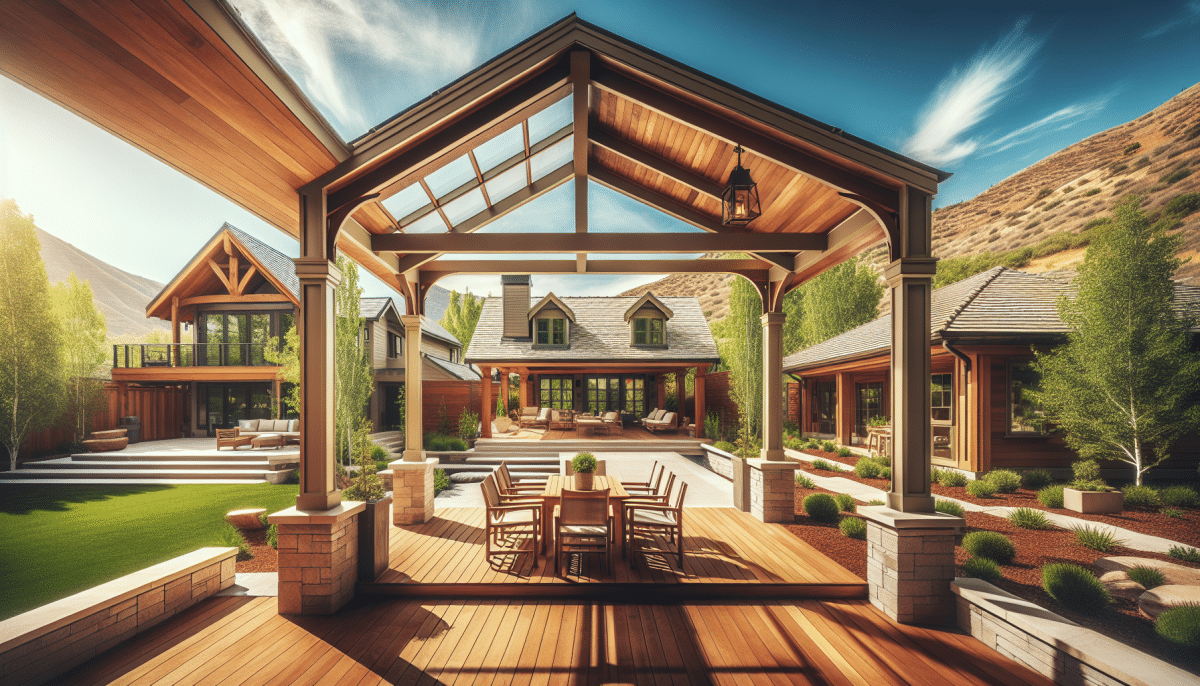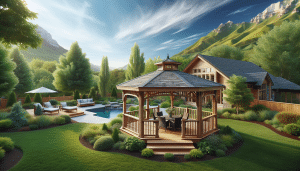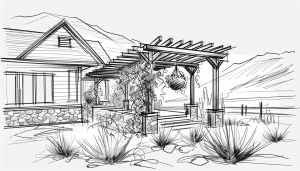Looking to spruce up your patio with a stunning cover, but not sure which Wood type to use? You’ve come to the right place! At Utah Pergola Company, we understand that choosing the best wood for your Patio Cover can be daunting. This guide will educate homeowners like you on the best wood types, ensuring your outdoor space is not only beautiful but durable too. Read on to make an informed decision and transform your patio into an inviting retreat.
Contents
- 1 Understanding Wood Types for Patio Covers
- 2 Benefits of Using Redwood
- 3 Why Choose Cedar for Your Patio Cover
- 4 The Magic of Douglas Fir
- 5 Top 5 Reasons to Use Pressure-Treated Wood
- 6 Choosing the Right Finish
- 7 Maintenance Tips for Wood Patio Covers
- 8 Matching Your Patio Cover with Home Design
- 9 Sustainable Wood Options
- 10 Budgeting for Your Wood Patio Cover
- 11 Conclusion
Understanding Wood Types for Patio Covers
When considering wood for your patio cover, it’s essential to understand the various types available. Each wood type offers unique characteristics and benefits. Let’s dive into the most popular wood types used for patio covers, helping you decide which one best suits your needs.
Firstly, let’s talk about Redwood. This wood is famous for its rich color and natural resistance to insects and decay. Redwood is not only beautiful but also durable.
Cedar is another excellent choice. Known for its natural resistance to rot and pests, cedar also emits a pleasant aroma. Its light Colors and soft texture make it a top pick among homeowners.
Benefits of Using Redwood
Redwood is a popular choice for patio covers, and for good reasons. This wood type brings a multitude of benefits to any outdoor space. Wondering why redwood stands out? Let us explain.
Firstly, redwood has a natural resistance to decay and pests, which means your patio cover will last longer and require less maintenance. Additionally, its rich, warm color adds a touch of elegance to any patio.
Moreover, redwood is lightweight yet strong, making it an excellent option for patio covers that need to be both sturdy and easy to install. It’s also eco-friendly, as it can be sourced from sustainably managed forests.
Why Choose Cedar for Your Patio Cover
Cedar might just be the perfect wood for your patio cover. Not only does it bring aesthetic appeal, but it also offers durability and pleasant aromas. Let’s explore why cedar is a great choice.
Cedar is renowned for its natural resistance to decay and insect infestation. This means less hassle and more relaxing time under your patio cover. Its unique scent also repels pests naturally.
Furthermore, cedar’s light color and fine texture provide a charming and timeless look. If you want your patio to have a cozy and inviting feel, cedar is the way to go.
The Magic of Douglas Fir
Douglas fir is another wood that deserves your consideration. Known for its strength and versatility, Douglas fir can make an outstanding patio cover. Why is it a good choice? Let us share the magic.
Douglas fir is incredibly durable and can withstand various weather conditions. Its strength makes it ideal for larger structures where stability is crucial. Moreover, this wood ages beautifully, adding character to your patio over time.
Another advantage of Douglas fir is its smooth finish. When properly treated and sealed, it showcases a beautiful, polished look that enhances the aesthetic of any outdoor space.
Top 5 Reasons to Use Pressure-Treated Wood
Pressure-treated wood is often considered for patio covers due to its special qualities. Let’s look at the top reasons why this wood type stands out for outdoor projects.
- Longevity: Pressure-treated wood lasts significantly longer than untreated wood, giving you value for your investment.
- Resistance: This type of wood is resistant to rot and insect damage, making it highly durable outdoors.
- Cost-Effective: It’s usually more affordable than other wood types, making it a great budget-friendly option.
- Versatility: Suitable for a variety of designs and finishes, it allows for more customization options.
- Availability: Pressure-treated wood is widely available, so you’ll have an easier time sourcing it for your project.
Choosing the Right Finish
Selecting the best finish for your patio cover is almost as important as choosing the wood itself. A proper finish can extend the life of your wood and enhance its natural beauty. Let’s discuss.
Whether you opt for staining or painting, the finish you choose should protect the wood from the elements. A high-quality stain can penetrate the wood, offering long-lasting protection while maintaining its natural look. Conversely, paint provides a more uniform appearance and can add a splash of color to your patio cover.
Remember, the finish you choose should depend on your aesthetic preferences and the wood type. For instance, a clear stain highlights the natural beauty of cedar, while a solid paint works well with pressure-treated wood.
Maintenance Tips for Wood Patio Covers
Maintaining your wood patio cover ensures its longevity and enhances its appearance. Here are some tips to keep it looking new and vibrant.
Firstly, regular cleaning is essential. Use a mild detergent and a soft brush to remove dirt and debris. Rinse thoroughly with water. Doing this every few months can prevent mold and mildew buildup.
Secondly, inspect your patio cover periodically for any signs of damage. Address any issues, such as cracks or splits, immediately to prevent them from worsening. Applying a fresh coat of stain or paint every couple of years can also help protect the wood.
Matching Your Patio Cover with Home Design
Choosing a patio cover that complements your home design is crucial for creating a cohesive outdoor space. Here’s how to achieve that perfect match.
Consider the architectural style of your home. For a rustic or traditional home, woods like cedar or redwood can enhance the natural, earthy tones. On the other hand, modern homes with sleek designs might benefit from the smooth finish of Douglas fir or a painted pressure-treated wood patio cover.
Furthermore, take into account the color palette of your home’s exterior. Your patio cover doesn’t have to match exactly, but it should harmonize with existing elements. A well-chosen wood type and finish can make your patio cover a seamless extension of your living space.
Sustainable Wood Options
Sustainability is a growing concern for many homeowners. Choosing eco-friendly wood options not only benefits the environment but also ensures that forests are managed responsibly. Let’s explore your options.
One excellent choice is reclaimed wood. This wood comes from old buildings, barns, or other structures and is given a new life. Using reclaimed wood reduces demand for freshly cut Timber and adds a unique, weathered look to your patio cover.
Sustainable forestry practices are another consideration. Look for wood that has been certified by organizations like the Forest Stewardship Council (FSC). These certifications ensure the wood is sourced from responsibly managed forests, protecting ecosystems and biodiversity.
Budgeting for Your Wood Patio Cover
Understanding the costs associated with different wood types can help you budget effectively for your patio cover project. Let’s look at some key budgeting tips.
Initially, consider the cost of the wood itself. Redwood and cedar are generally more expensive due to their desirable properties. Pressure-treated wood tends to be more affordable, but remember to factor in the cost of treatments and finishes.
Additionally, account for installation costs. While some wood types might be easier to work with, others may require professional installation. Include these potential labor costs in your budget to avoid any surprises. Lastly, factor in maintenance expenses over time, such as cleaning supplies and finishes, to keep your patio cover in top shape.
Conclusion
For top-quality wood patio covers in Utah, contact Utah Pergola Company by phone # 801-784-6082 or Request a Free Quote.




